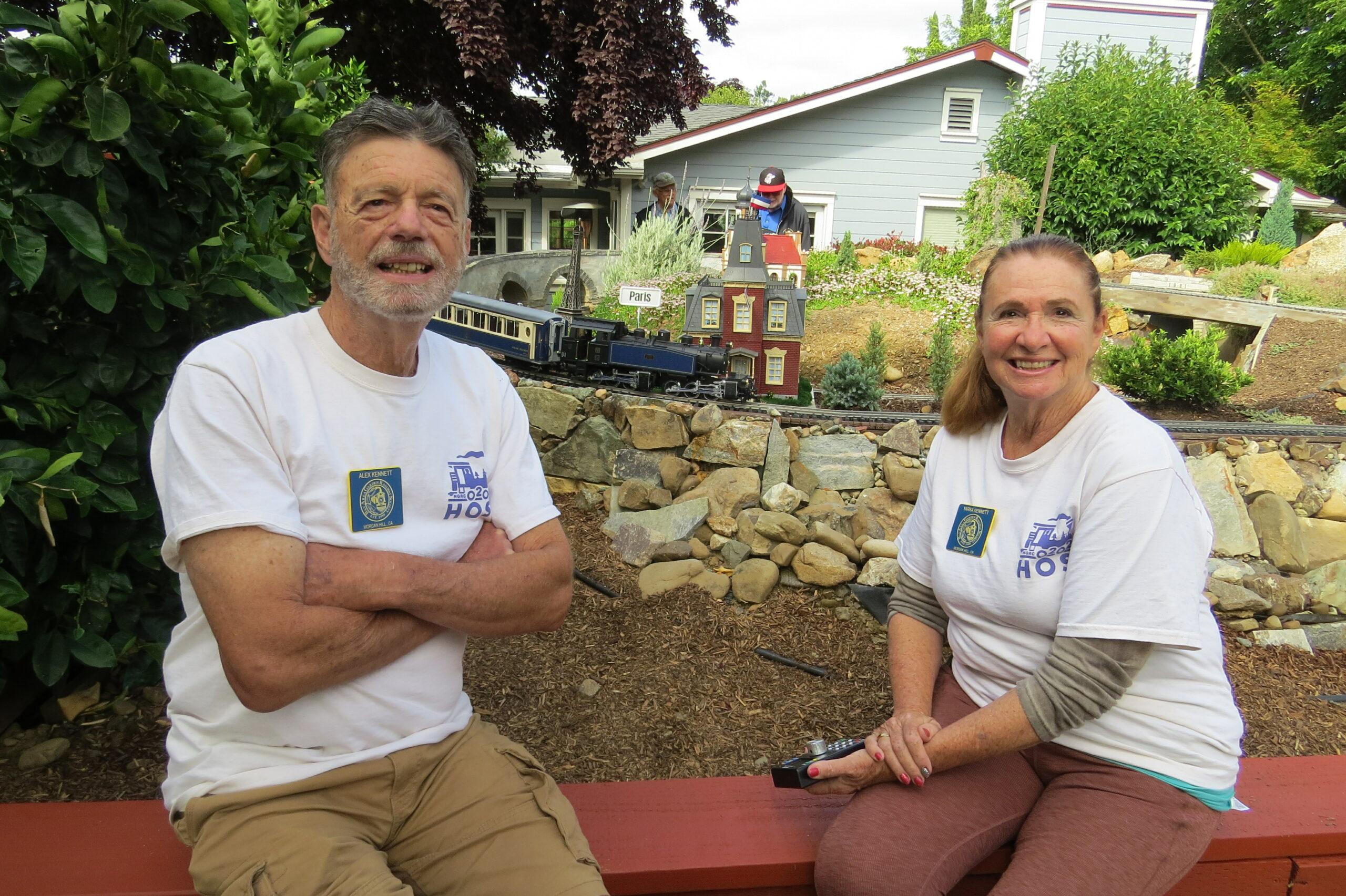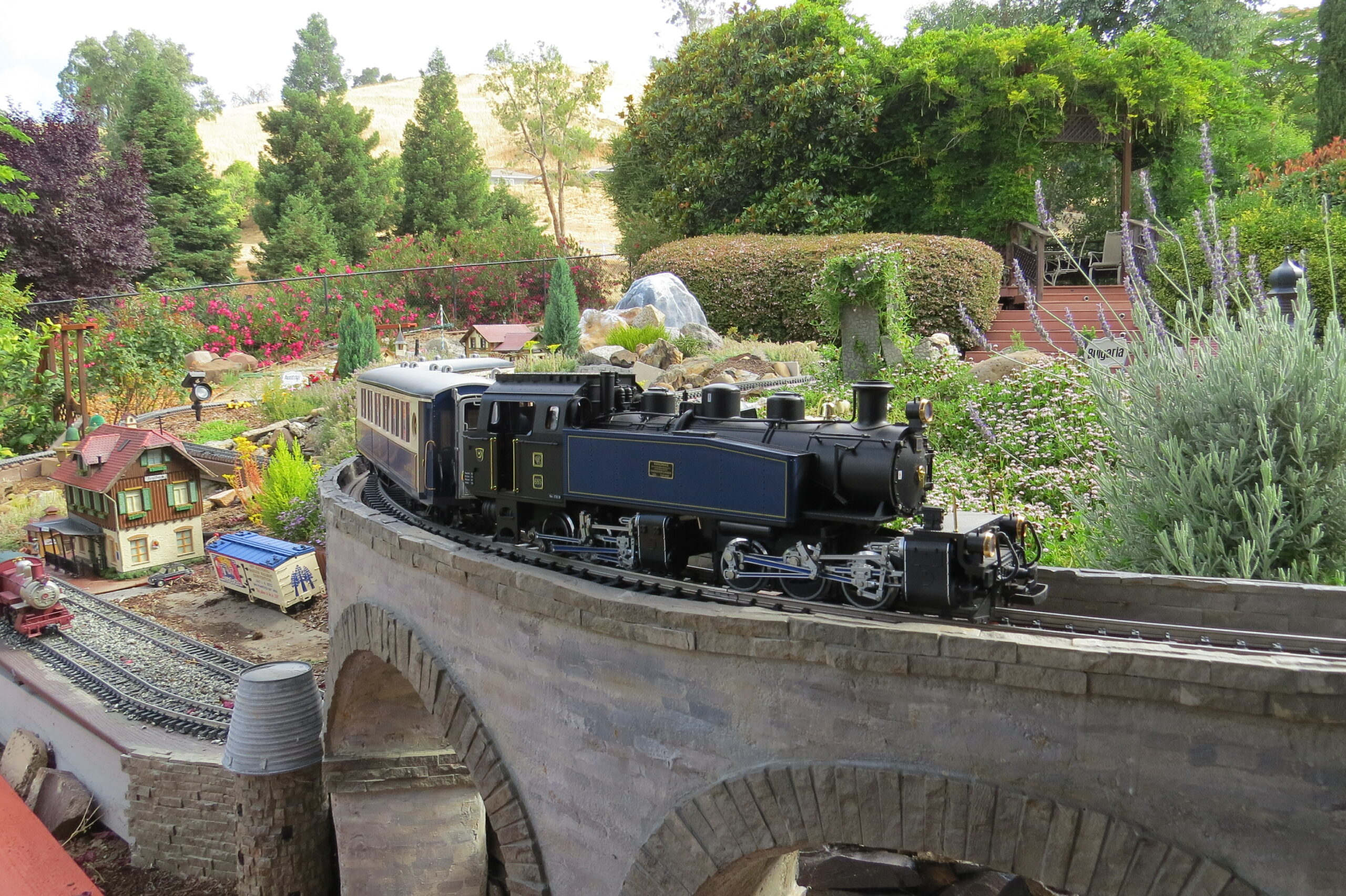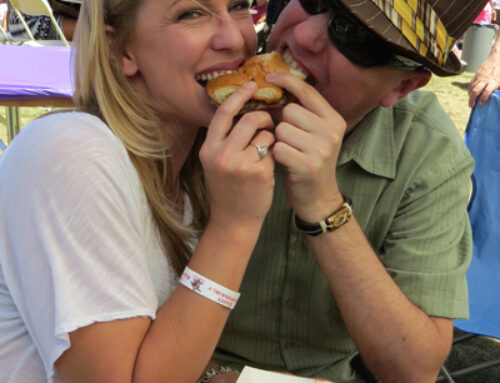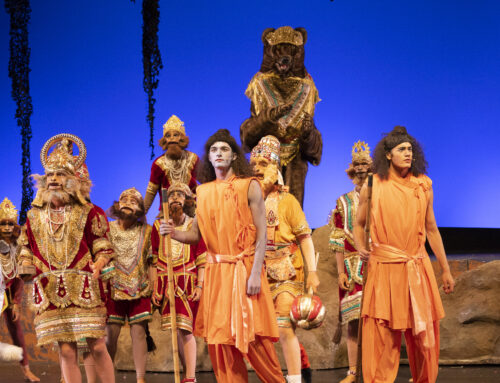MH’s Kennetts created train system that runs from Paris to Istanbul

Alex and Yarka Kennett in front of their MorganHill backyard railroad garden. Photo by Calvin Nuttall
By Calvin Nuttall
While some Morgan Hill homeowners might fill their backyards with flower beds, vegetable gardens, or a pool, Alex and Yarka Kennett’s outdoor decor would not be complete without their working scale model of the iconic luxury railway the Orient Express.
Wending its way through sculpted grassy hills and hand-painted snowy mountains, past miniature train stations and dollhouse-scale villages, the battery-powered replica train meanders through a tiny Europe in the couple’s backyard.

Photo by Calvin Nuttall
“I’ve just always loved trains,” Yarka said as she watched her radio-controlled engine valiantly haul its complement of passenger cars up the slopes of the Austrian Alps. “And I’ve always loved the Orient Express, its history and all of the stories about it. So we thought it would be fun to recreate it.”
Built in the late 19th century, the real Orient Express was a passenger railway that traveled the length of continental Europe. While it was at first an unremarkable railway service, the Express has been portrayed in countless pieces of film and literature over the years, earning it a luxurious mystique.
As first- and second-generation European immigrants respectively, Yarka and Alex view their homage to the iconic railway as a way to celebrate their heritage. A retired architect, Yarka is the artistic force behind the project. A real estate broker and board member for the Santa Clara Valley Open Space Authority, Alex fashions the terrain and lays the tracks that guide the little locomotive around the backyard diorama.
“I have the ideas, and he makes them come into reality,” Yarka said. “We learned a lot of new techniques. We learned to work with cement and concrete and stone. Everything you see is a live plant. I just hope they don’t get too big!”
The Kennetts are members of the Bay Area Garden Railway Society, a group dedicated to outdoor miniature train projects like theirs. One of the largest such groups in North America, the BAGRS (or ‘Baggers,’ as the Kennetts call them) recently hosted an international convention July 1-9 which attracted participants from as far as Japan and Australia to admire society members’ displays.
“The whole Santa Clara Convention Center was taken over with rail layouts,” Yarka said. “People came from all over the world. Some even had live steam engines with real coal and water powering the train.”

Photo by Calvin Nuttall
Founded in 1988, the BAGRS was created to support the development of a community of garden railway enthusiasts in the Bay Area by providing resources to members such as tours of existing rail layouts, organizing clinics, publishing a monthly newsletter and managing the National Garden Railway Convention. The society is home to about 300 members.
The miniature railway hobby originated in Germany. The country is home to the world’s largest miniature railway installation, where many of the manufacturers of equipment for the hobby are based.
“I had to order this one from Germany,” Yarka said, referring to the Orient Express replica engine. “It is a special edition that is no longer made, and that was the only place I could find one.”
This year was the Kennetts’ first time having their own railway showcased in the convention. The BAGRS arranged for buses to transport convention-goers between homes of society members who have permanent displays installed. They were excited to welcome visitors to their open house July 7, though some parts of their display remained incomplete.
“It is never done,” Yarka said. “There is always something to fix or something new to add. We started building it in August two years ago, and there are still some features that are under construction.”

Photo by Calvin Nuttall
One such unfinished feature is the model representing Paris, which was the western terminus of the Orient Express. From there, their railway crosses the bulk of Europe and passes over the Alps, where the Kennetts have installed a waterfall which flows down from the concrete mountains to eventually fill the Black Sea. There the train arrives at Istanbul, its eastern terminus.
“There’s our Black Sea monster now,” Yarka cautioned, indicating a rubber ducky floating on the tranquil pond.
The artistic features of the railway’s course are partially built from kits and partially hand-made by the Kennetts. Yarka aspires to build more of the buildings and villages by hand as the project progresses.
To qualify as a garden railway by the BAGRS definition, miniature rail displays have to be constructed outside where they are exposed to the elements. This requirement makes certain aspects of the design challenging.
“These are all battery-powered trains, mainly because outdoor track is really difficult to keep clean and connected for electrical power,” Yarka said. “This one doesn’t go that fast because it is a much heavier engine due to the battery, and the electrical power is only so much.”
Unlike the historical Orient Express, which was a linear railway, the layout of the Kennetts’ track is arranged in a shape called a folded loop. This is a continuous path that folds in on itself, such that the train always returns to its starting point beside the river Seine. Two trains share the tracks, one modeled after the Orient Express, and a smaller one labeled “Napa Valley” which hauls box cars, an anachronistic nod to Northern California’s regional rail history.
A constantly evolving project, the serene railway diorama is a testament to the creativity and skill of its creators and their harmonious teamwork. Though the Orient Express no longer plies the railways of central Europe, its romantic mystique lives on through the ardent dedication of these local artists.
Calvin Nuttall is a Morgan Hill-based freelance reporter.






